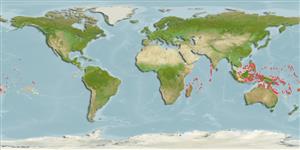>
Gobiiformes (Gobies) >
Gobiidae (Gobies) > Gobiinae
Etymology: Macrodontogobius: Greek, makros = great + Greek, odous = teeth + Latin, gobius = gudgeon (Ref. 45335).
Eponymy: Dr Ray Lyman Wilbur (1875–1949) was an American physician who became the third President of Stanford University (1916–1943), which had awarded his BA (1896) and MA (1897), and the 31st US Secretary of the Interior (1929–1933) appointed by Hoover. [...] (Ref. 128868), visit book page.
More on author: Herre.
Environment: milieu / climate zone / depth range / distribution range
Écologie
marin; saumâtre récifal; profondeur 0 - 20 m (Ref. 48637), usually 1 - 10 m (Ref. 90102). Tropical; 15°N - 30°S
Indo-Pacific: Seychelles eastward into Oceania, including Micronesia, Fanning, and Phoenix islands.
Taille / Poids / Âge
Maturity: Lm ? range ? - ? cm
Max length : 6.5 cm SL mâle / non sexé; (Ref. 48637)
Épines dorsales (Total) : 7; Rayons mous dorsaux (Total) : 9 - 11; Épines anales: 1; Rayons mous anaux: 9 - 10; Vertèbres: 26. Ground color of dorsal part of body greenish brown, ventral whitish yellow; a black spot at base of caudal fin; 7 dark brown blotches longitudinally arranged in mid-lateral area; black spots on cheeks and operculae, one ventral to the eye; pectoral fins hyaline; white pelvic fins. Pigment intensity variable among localities. 7 or less predorsal scales. Large, ctenoid scales except for cycloid scales in isthmus (Ref. 403); pelvic fins united with well-developed frenum; rounded caudal fin, slightly longer than head; longitudinal scale series 27-31; fully scaled cheek and opercle; depth of body 4.6-6.3 in SL (Ref. 90102).
Inhabits coastal bays, lagoons and estuaries on fine sand along reef margins to about 20 meters depth (Ref. 48637). Solitary (Ref. 90102). Specimens collected from shallow waters to 7 m, near coral reefs. In southern Japan, the species inhabits sandy bay bottoms.
Life cycle and mating behavior
Maturité | Reproduction | Frai | Œufs | Fécondité | Larves
Murdy, E.O., 1985. A review of the gobiid fish genera Exyrias and Macrodontogobius, with description of a new species of Exyrias. Indo-Pac. Fish. (10):14 p. (Ref. 403)
Statut dans la liste rouge de l'IUCN (Ref. 130435: Version 2024-2)
Menace pour l'homme
Harmless
Utilisations par l'homme
Outils
Articles particuliers
Télécharger en XML
Sources Internet
Estimates based on models
Preferred temperature (Ref.
123201): 25.4 - 29.3, mean 28.5 °C (based on 2331 cells).
Phylogenetic diversity index (Ref.
82804): PD
50 = 1.0000 [Uniqueness, from 0.5 = low to 2.0 = high].
Bayesian length-weight: a=0.01023 (0.00477 - 0.02194), b=3.01 (2.83 - 3.19), in cm total length, based on LWR estimates for this (Sub)family-body shape (Ref.
93245).
Niveau trophique (Ref.
69278): 2.8 ±0.4 se; based on diet studies.
Résilience (Ref.
120179): Haut, temps minimum de doublement de population inférieur à 15 mois (Preliminary K or Fecundity.).
Fishing Vulnerability (Ref.
59153): Low vulnerability (10 of 100).
Nutrients (Ref.
124155): Calcium = 162 [79, 360] mg/100g; Iron = 0.94 [0.46, 1.78] mg/100g; Protein = 18.5 [16.5, 20.1] %; Omega3 = 0.157 [0.068, 0.304] g/100g; Selenium = 19.1 [9.4, 46.5] μg/100g; VitaminA = 138 [36, 473] μg/100g; Zinc = 2.94 [1.92, 4.37] mg/100g (wet weight);
